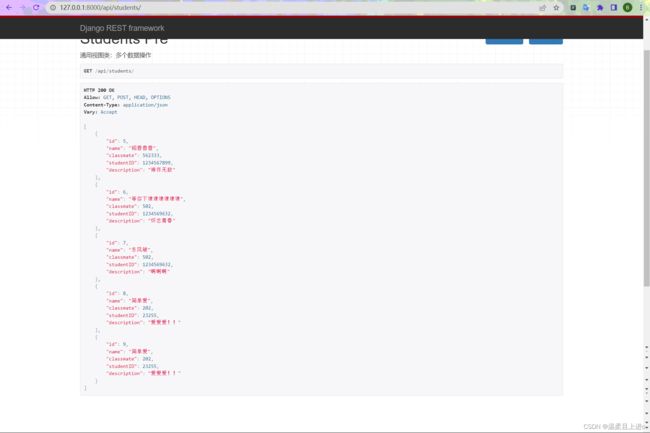python Django Rest_Framework框架 认证、权限、限流功能组件详解(图文并茂版)
认证、权限、限流功能组件详解
- 准备工作
- 认证 Authentication
-
- 局部设置
-
- 自定义认证组件
- 全局配置
- 权限 Permissions
-
- 局部配置
-
- 提供的权限类
- 自定义权限组件
- 全局配置
- 限流 Throttling
-
- 局部配置
-
- 提供的限流类
准备工作
首先我们为了方便下面的练习,先创建一个新的子应用api
python manage.py startapp api
注册创建的子应用:
INSTALLED_APPS = [
...
'api', # drf的组件使用
]
- 因为接下来的认证组件中需要使用到登陆功能,所以我们使用django内置admin并创建一个超级管理员
- admin站点的访问地址:http://127.0.0.1:8000/admin
- 在终端行运行下述命令创建超级管理员
python manage.py createsuperuser
- 你也可以修改你已经创建好的超级管理员的密码:
python manage.py changepassword 用户名
LANGUAGE_CODE = 'zh-hans'
TIME_ZONE = 'Asia/Shanghai'
认证 Authentication
可以在配置文件中配置全局默认的认证方法,查看全局的默认配置:
DEFAULTS = {
...
'DEFAULT_AUTHENTICATION_CLASSES': [
'rest_framework.authentication.SessionAuthentication', # session认证
'rest_framework.authentication.BasicAuthentication' # 基本认证
],
...
}
常见的认证方式:cookie、session、token
局部设置
- 可以在具体的视图类中通过设置authentication_classess类属性来设置单独的不同的认证方式
from rest_framework import status
from rest_framework.authentication import SessionAuthentication, BasicAuthentication
from rest_framework.response import Response
from rest_framework.views import APIView
class StudentsView(APIView):
authentication_classes = [SessionAuthentication, BasicAuthentication]
def get(self, request):
if not request.user.id:
return Response({'msg': '未验证通过!!'}, status=status.HTTP_401_UNAUTHORIZED)
return Response({'msg': '验证成功!!'}, status=status.HTTP_200_OK)
自定义认证组件
- 也可以自定义认证组件:
from django.contrib.auth import get_user_model
from rest_framework.authentication import BaseAuthentication
class UserAuthentication(BaseAuthentication):
"""
自定义认证方法
"""
def authenticate(self, request):
"""
认证方法
:param request: 客户端发送的http请求对象
:return: True: (user,None) False: (None)
"""
user = request.query_params.get('user')
pwd = request.query_params.get('pwd')
if user != 'ycx' and pwd != '........':
return None
user = get_user_model().objects.first()
return (user, None)
- 自定义认证:从路由地址中获取信息,判断用户名与密码是否验证通过,不通过固定返回None,通过返回(user, None)
- 然后在视图中的authentication_classes进行引用使用:
from rest_framework import status
from rest_framework.response import Response
from rest_framework.views import APIView
from .authentication import UserAuthentication
class StudentsView(APIView):
authentication_classes = [UserAuthentication]
def get(self, request):
if not request.user.id:
return Response({'msg': '未验证通过!!'}, status=status.HTTP_401_UNAUTHORIZED)
return Response({'msg': '验证成功!!'}, status=status.HTTP_200_OK)
全局配置
- 在settings.py文件中的REST_FRAMEWORK中进行配置:
"""drf配置信息必须全部写在REST_FRAMEWORK配置项中"""
REST_FRAMEWORK = {
'DEFAULT_AUTHENTICATION_CLASSES': (
'api.authentication.UserAuthentication', # 自定义认证
'rest_framework.authentication.SessionAuthentication', # session认证
'rest_framework.authentication.BasicAuthentication', # 基本认证
)
}
权限 Permissions
局部配置
权限控制可以限制用户对于视图的访问和对于具有模型对象的访问
对于用户的权限限制,共有两个方面:
- 在执行视图的as_view()方法的dispatch()方法前,会先进行视图访问权限的判断
- 在通过get_object()获取具体模型对象时,会进行模型对象访问权限的判断
提供的权限类
- AllowAny 允许所有用户,默认权限
- IsAuthenticated 仅通过登录认证的用户
- IsAdminUser 仅管理员用户
- IsAuthenticatedOrReadOnly 已经登陆认证的用户可以对数据进行增删改操作,没有登陆认证的只能查看数据
class StudentsPreView(GenericAPIView):
"""通用视图类:多个数据操作"""
# 独特操作
queryset = Students.objects.all()
serializer_class = StudentModelSerializers
authentication_classes = [SessionAuthentication]
permission_classes = [IsAuthenticatedOrReadOnly]
def get(self, request):
# 获取查询到的模型数据集
ser = StudentModelSerializers(instance=self.get_queryset(), many=True)
return Response(ser.data, status=status.HTTP_200_OK)
def post(self, request):
ser = self.get_serializer(data=request.data)
# raise_exception:自动将报错信息返回给页面
ser.is_valid(raise_exception=True)
ser.save()
return Response(ser.data, status=status.HTTP_201_CREATED)
- 上述使用的IsAuthenticatedOrReadOnly权限类为:登录认证的用户可以查看、修改数据,未登录的用户只能查看数据
未登录页面显示:

- 登录用户页面显示:

- 登录用户的最下方提供增加数据的权限
自定义权限组件
如需自定义权限,需继承rest_framework.permissions.BasePermission父类,并实现以下两个任何一个方法或全部
-
.has_permission(self, request, view):是否可以访问视图, view表示当前视图对象,返回值:True或False,允许访问视图或不允许
-
.has_object_permission(self, request, view, obj):是否可以访问模型对象, view表示当前视图对象, obj为模型数据对象,返回值:True或False,允许访问模型对象或不允许
-
定义:自定义permissions.py文件:
from rest_framework.permissions import BasePermission
class StudentsPermission(BasePermission):
"""
自定义权限组件:全局配置或局部配置
"""
def has_permission(self, request, view):
"""
视图权限
:param request:请求对象
:param view:要访问的视图类
:return:True或False
"""
# 获取
name = request.query_params.get('name')
return name == 'ycx'
def has_object_permission(self, request, view, obj):
"""
模型权限
:param request:请求对象
:param view:访问视图对象
:param obj:模型数据对象
:return:True或False
"""
return True
- 调用:在视图文件中引入自定义的权限认证类,再将此认证类添加到permission_classes中,即可完成调用!!
- 我们在这里定义的权限类为:从路由中获取用户姓名信息,判断此用户是否具有访问视图与模型的权限
- 未添加用户信息:

- 添加正确的用户信息:

全局配置
- 在settings.py文件中的REST_FRAMEWORK中进行配置:
REST_FRAMEWORK = {
# 认证全局配置
'DEFAULT_AUTHENTICATION_CLASSES': (
'api.authentication.UserAuthentication', # 自定义认证
'rest_framework.authentication.SessionAuthentication', # session认证
'rest_framework.authentication.BasicAuthentication', # 基本认证
),
# 权限全局配置
'DEFAULT_PERMISSION_CLASSES': [
'rest_framework.permissions.IsAuthenticated',
'api.permissions.StudentsPermission' # 自定义权限
]
}
限流 Throttling
- 限流组件,可以对接口访问的频次进行限制,以减轻服务器压力,或者实现特定的业务
- 作用:一般用于付费购买次数,投票等场景使用
局部配置
提供的限流类
- AnonRateThrottle:限制所有匿名未认证用户,使用IP区分用户
使用DEFAULT_THROTTLE_RATES[‘anon’] 来设置频次
- UserRateThrottle:限制认证用户,使用User模型的 id主键来区分
使用DEFAULT_THROTTLE_RATES[‘user’] 来设置频次
- ScopedRateThrottle:限制用户对于每个视图的访问频次,使用ip或用户id
class StudentsPreView(GenericAPIView):
"""通用视图类:多个数据操作"""
# 独特操作
queryset = Students.objects.all()
serializer_class = StudentModelSerializers
# 限流
throttle_classes = [UserRateThrottle]
def get(self, request):
# 获取查询到的模型数据集
ser = StudentModelSerializers(instance=self.get_queryset(), many=True)
return Response(ser.data, status=status.HTTP_200_OK)
def post(self, request):
ser = self.get_serializer(data=request.data)
# raise_exception:自动将报错信息返回给页面
ser.is_valid(raise_exception=True)
ser.save()
return Response(ser.data, status=status.HTTP_201_CREATED)
在settings.py文件中配置访问频次:
# 限流频率配置
'DEFAULT_THROTTLE_RATES': { # 频率配置
'anon': '2/day', # 针对游客的访问频率进行限制
'user': '5/day', # 针对登录用户的访问频率进行限制
}






